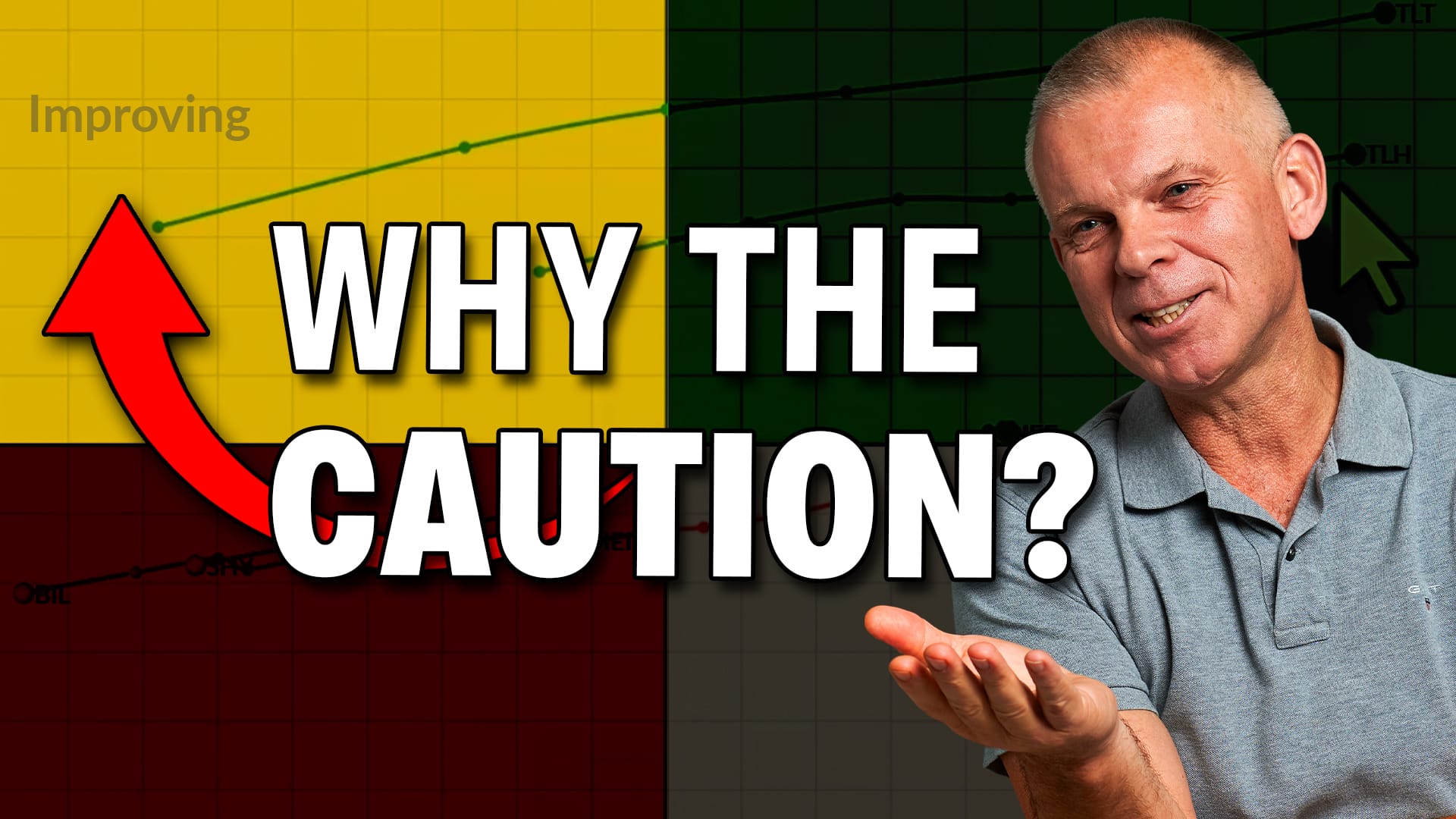QQQ SHOWS RELATIVE WEAKNESS -- RSI STALLS IN RESISTANCE ZONE FOR QQQ -- SPY TESTS DOUBLE BOTTOM BREAKOUT -- GOLD SURGES OFF LONG-TERM SUPPORT -- GLD NEGATES BEAR FLAG WITH UPSIDE BREAKOUT -- SILVER ETF MOVES ABOVE RESISTANCE
QQQ STARTS SHOWING RELATIVE WEAKNESS ... Link for todays video. The Nasdaq 100 ETF (QQQ) was a market leader from June to September, but is turning into a market laggard here in October. Chart 1 shows QQQ surging off support in early October with a move above 58. The ETF was one of the few ETFs to actually hold above the August lows. This showed less weakness at the time, which is another term for relative strength. QQQ surged over 15% the first two weeks of October and then met resistance around 58. After chopping around for another week or so, the ETF declined sharply on Tuesday with a long black candlestick. These are also known as filled candlesticks. A filled or black candlestick forms when the close is well below the open. In other words, prices moved lower after the open and the close was weak. Despite Tuesdays selling and Wednesdays dip below 56.50, QQQ remains above support form last weeks low. It has yet to actually break down. A move below this level would forge a lower high (below the July high). The combination of a lower high and support break would be quite negative, should it happen. The indicator window shows the Price Relative (QQQ:SPY ratio) forming two equal highs and then breaking its late September low. This means QQQ is now underperforming the S&P 500 ETF (SPY).

(click to view a live version of this chart)
Chart 1
Chart 2 shows weekly candlesticks over the last two years. QQQ first surged above 58 in February and has met resistance in the 58-59.5 area the entire year. This is a pretty formidable resistance zone. A breakout would be very bullish for this large-cap technology ETF. But it hasnt happened just yet. After a long white candlestick three weeks ago, QQQ formed a smaller black candlestick within this range two weeks ago. These two candlesticks form a Harami, which signals indecision. Indecision is continuing this week as prices failed to hold above 58 on Monday.
RSI STALLS IN RESISTANCE ZONE FOR QQQ... Chart 2 shows weekly candlesticks over the last two years. QQQ first surged above 58 in February and has met resistance in the 58-59.5 area the entire year. This is a pretty formidable resistance zone. A breakout would be very bullish for this large-cap technology ETF. But it hasnt happened just yet. After a long white candlestick three weeks ago, QQQ formed a smaller black candlestick within this range two weeks ago. These two candlesticks form a Harami, which signals indecision. Indecision is continuing this week as prices failed to hold above 58 on Monday.

(click to view a live version of this chart)
Chart 2
The indicator window shows RSI holding the 40-50 zone the first 18 months. Momentum favored the bulls as long as RSI traded in the 50-80 zone. RSI broke below 40 in mid August and the 50-60 zone is now acting as resistance. According to RSI guru Andrew Cardwell, RSI is in bear mode when it ranges from 20 to 60. A move back above 60 is needed to put weekly momentum back on the bullish track.
SPY TESTS DOUBLE BOTTOM BREAKOUT... In the October 12th Market Message, I compared and contrasted the Double Bottoms from 2008 and 1998. In both cases, the S&P 500 formed two relatively equal lows and broke above resistance. The 1998 Double Bottom featured a strong surge off the second low and breakout that never looked back. In other words, the breakout held and there was no pullback. The 2008 Double Bottom featured a slower advance off the second low and a rising wedge formed. The Double Bottom breakout failed to hold and the S&P 500 broke wedge support to reverse the uptrend. Chart 3 shows the 1998 Double Bottom for reference.

(click to view a live version of this chart)
Chart 3
Admittedly, the current Double Bottom looks more like the 1998 Double Bottom, which was a successful bullish pattern. First, chart 4 shows SPY failing to hold the support break at 110 and reversing with a big turnaround day. Second, the follow through surge was very strong. Third, the ETF consolidated just below resistance. Fourth, SPY broke through resistance with last weeks move above 123. Even though SPY fell back on Tuesday, the breakout is still holding. We should allow a little wiggle room, but just how much? I think the consolidation lows around 119 hold the key. Successful breakouts hold and failures fold. A move back below 119 would mark a major failure and call for a reassessment.

(click to view a live version of this chart)
Chart 4
The indicator window shows the Stochastic Oscillator (125,3). 125 days represents around six months of trading days or half a year. In general, prices are above the mid point of the six month high-low range when this indicator is above 50 and below the mid point when below 50. It is a half-empty or half-full type indicator. Right now the cup is half full as the indicator moved above 50 last week. A move back below 50 would put the cup at half empty and call for a reassessment.
GOLD SURGES OFF LONG-TERM SUPPORT... John Murphy noted strength in gold on Tuesday and also pointed out that the Gold Miners ETF (GDX) was surging off support. The Gold SPDR (GLD) is also making a move off support with this weeks move above 165. Chart 5 shows the Gold SPDR (GLD) with weekly candlesticks extending back three years. The ETF remains in a rising channel that defines a clear uptrend. There have been pullbacks and consolidations along the way, but the channel has held throughout. As noted in prior commentaries, three chart features define support in the 150-155 area. First, GLD retraced 50-61.80% of the 2011 advance. Second, broken resistance from the triangle breakout turns into support. Third, the lower trendline of the rising channel marks support.

(click to view a live version of this chart)
Chart 5
We can also add a fourth item to the mix. The indicator window shows the TRIX Oscillator (5,3) firming near -.5%. Notice how the indicator turned up in the 0 to -.5% area four times in the last three years. A move above the signal line would indicate that the 5-period triple smoothed exponential moving average was turning up. TRIX measures the Rate-of-Change for a triple smoothed EMA. In this case, we are using a 5-period triple smoothed EMA (5 weeks). TRIX is positive when the EMA turns up and negative when the EMA turns down. Quicker signals can be had by looking for moves above/below the trigger line, which is a 3-period EMA of the TRIX Oscillator. You can read more about this indicator in our ChartSchool Article
GLD NEGATES BEAR FLAG WITH UPSIDE BREAKOUT... I also wrote about the possibility of a bear flag forming on the daily chart for GLD. Chart 6 shows daily candlesticks with this pattern developing from late September to late October. In fact, it looked like this pattern would be confirmed soon after last weeks dip below 157.50. However, GLD quickly recovered and surged back above 167 on Tuesday-Wednesday. This strong move puts GLD at its high for the month and above the rising flag trendline. A rising flag should hold its boundaries before a breakdown. This break above the upper trendline negates the rising flag and suggest that the bigger uptrend is continuing.

(click to view a live version of this chart)
Chart 6
The indicator window shows the Commodity Channel Index (CCI) surging above +100. Donald Lambert, creator of CCI, suggested that a surge above +100 signals the start of an advance, while a plunge below -100 signals the start of a decline. Of course, not all signals result in extended moves. Even though there will be whipsaws (bad signals), it would not be wise to ignore such a strong move in momentum, especially off support. At this point, the onus is on the bears to prove the bullion bulls otherwise. Look for a move below 157.50 to do this.
SILVER ETF MOVES ABOVE RESISTANCE... Chart 7 shows the Silver Trust (SLV) with a similar surge and breakout at 32. Last weeks low now marks an important support level at 29. MACD continues to rise as it trades above its signal line. MACD could move to the zero line and SLV could retrace 50-61.80% of the prior decline. As a quasi-industrial metal, silvers fortunes are more tied to the stock market and economic expectations. A decline in stocks would likely weigh on industrial metals, while continued strength would be positive.









